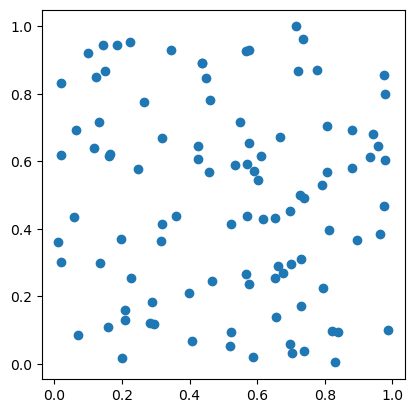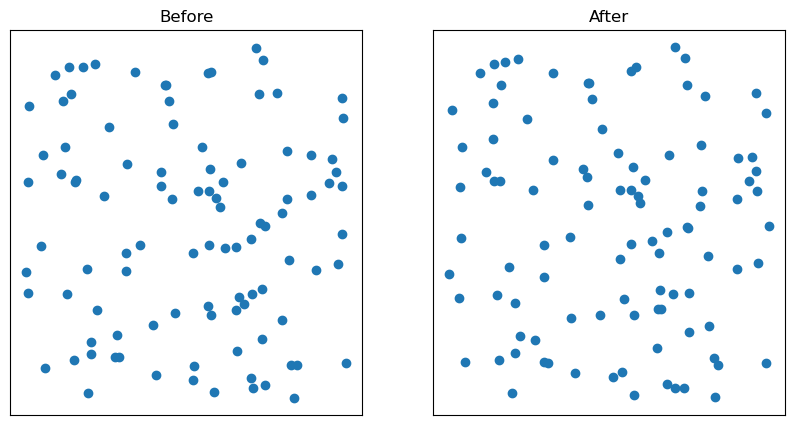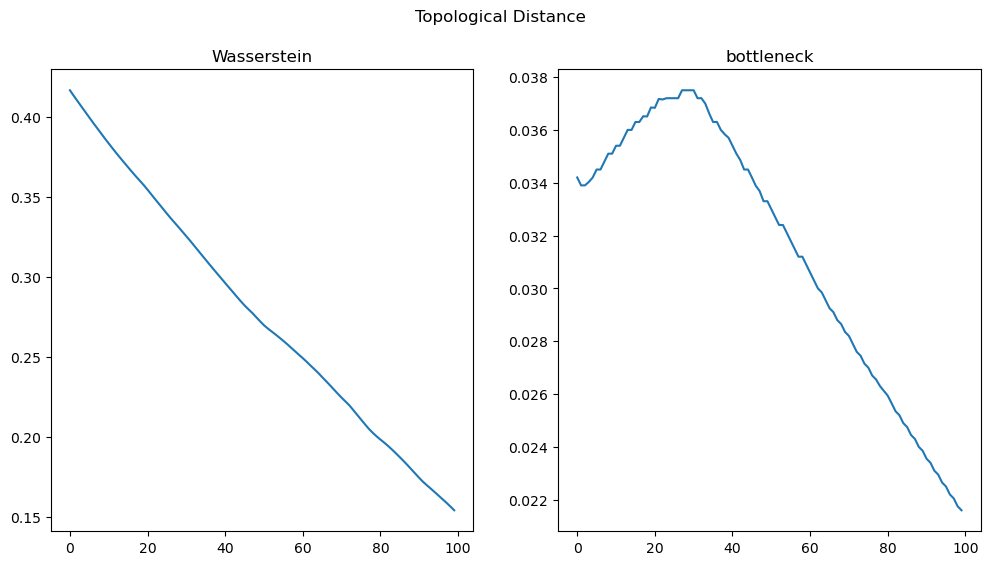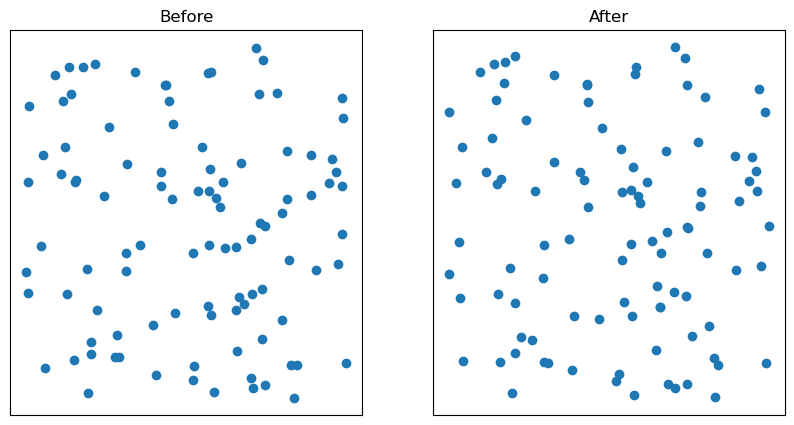Optimization with Diagram Distances¶
IDEA: Let PD(X) be the persistence diagrams on a data set X. We will do optimization on a different dataset \(Y\) to decrease dist(PD(X), PD(Y)), where the distance function dist() is Wasserstein or Bottleneck.
[1]:
import time
import torch
import torch.nn as nn
import torch_tda
import numpy as np
import matplotlib.pyplot as plt
import bats
from tqdm import tqdm
import hera
[2]:
n = 100
np.random.seed(0)
data = np.random.uniform(0,1,(n,2))
fig1 = plt.scatter(data[:,0], data[:,1])
fig1.axes.set_aspect('equal')
X = torch.tensor(data, requires_grad=True)

[3]:
# Compute H1 and H0
# maximum homology dimension is 1, which implies C_2 needed
# flags = (bats.standard_reduction_flag(), bats.compute_basis_flag())
flags = (bats.standard_reduction_flag(),bats.compression_flag())
# flags = ()
layer = torch_tda.nn.RipsLayer(maxdim = 1, reduction_flags=flags)
# dgms = layer(X) # run FlagDiagram.forward()
[4]:
dgm0 = layer(X)
[5]:
dgm0[1][0] # the finite length persistence pairs of dim 1
[5]:
tensor([[0.0375, 0.0375],
[0.0400, 0.0400],
[0.0443, 0.0443],
...,
[0.6572, 0.6572],
[0.6575, 0.6575],
[0.6577, 0.6577]], dtype=torch.float64, grad_fn=<CopyBackwards>)
Output Format of Persistent Diagram
Inspired by Gudhi, we adopt the ouput pattern that divides essential and regular persistence pairs apart.
Output: list (length 4) of persistence diagrams in each dimension. We separate them by dimension and regular/essential, which are 0-dim regular pairs, 1-dim regular pairs, 0-dim essential pair(only one in the case Rips) and so
Return type of layer(X) is : List of - tensor[float] of shape (n-1,2), where n is the number of points - List[tensor[float] of shape (m,2)] - tensor[float] of shape (1,1) - List[tensor[float] of shape (k,)]
[6]:
f1 = torch_tda.nn.BarcodePolyFeature(2,0)
we’ll produce a perturbed data set
[7]:
# take a few gradient descent steps
optimizer = torch.optim.Adam([X], lr=1e-2)
for i in tqdm(range(2)):
optimizer.zero_grad()
dgms = layer(X)[1][0]
loss = -f1(dgms)
loss.backward()
optimizer.step()
100%|███████████████████████████████████████████████████████████████████████████████████████████████████████████████████████████████| 2/2 [00:00<00:00, 3.89it/s]
[8]:
y = X.detach().numpy()
fig, ax = plt.subplots(ncols=2, figsize=(10,5))
ax[0].scatter(data[:,0], data[:,1])
ax[0].set_title("Before")
ax[1].scatter(y[:,0], y[:,1])
ax[1].set_title("After")
for i in range(2):
ax[i].set_yticklabels([])
ax[i].set_xticklabels([])
ax[i].tick_params(bottom=False, left=False)
plt.show()

Now, let’s try to decrease a diagram distance between the two diagrams.
You can use torch_tda.nn.WassersteinLayer()
[9]:
def remove_zero_bars(dgm):
"""
remove zero bars from diagram
"""
inds = dgm[:,0] != dgm[:,1]
return dgm[inds,:], dgm[~inds,:]
def bott_dist(in_dgm1, in_dgm2, zero_out = False):
# compute bottleneck distance
if not zero_out:
dgm1, zero_dgm1 = remove_zero_bars(in_dgm1)
dgm2, zero_dgm2 = remove_zero_bars(in_dgm2)
d1 = dgm1.detach().numpy()
d2 = dgm2.detach().numpy()
# find the bottleneck distance and the maixmum edge (two points in R^2)
dist, edge = hera.bottleneck_dist(d1, d2, return_bottleneck_edge=True)
return dist
[10]:
import time
DB = torch_tda.nn.WassersteinLayer()
dgm01cpy = dgm0[1][0].detach()
bot_dist = []
# take a few gradient descent steps
optimizer = torch.optim.Adam([X], lr=1e-4)
losses = []
tph = [] # time to compute persistent homology
tdb = []
for i in tqdm(range(100)):
optimizer.zero_grad()
t0 = time.monotonic()
dgms = layer(X)
t1 = time.monotonic()
tph.append(t1 - t0)
dgms0 = dgms[1][0]
t0 = time.monotonic()
loss = DB(dgms0, dgm01cpy) # compute Wasserstein distances btw 2 diagrams
bot_dist.append(bott_dist(dgms0, dgm01cpy))
t1 = time.monotonic()
tdb.append(t1 - t0)
losses.append(loss.detach().numpy())
loss.backward()
optimizer.step()
np.mean(tph), np.mean(tdb)
100%|███████████████████████████████████████████████████████████████████████████████████████████████████████████████████████████| 100/100 [00:19<00:00, 5.08it/s]
[10]:
(0.1917883182800233, 0.0027503665100039143)
[11]:
fig, (ax0, ax1) = plt.subplots(nrows=1, ncols=2, sharex=True,
figsize=(12, 6))
ax0.set_title('Wasserstein')
ax0.plot(losses)
ax1.set_title('bottleneck')
ax1.plot(bot_dist)
fig.suptitle('Topological Distance')
plt.show()

[12]:
y = X.detach().numpy()
fig, ax = plt.subplots(ncols=2, figsize=(10,5))
ax[0].scatter(data[:,0], data[:,1])
ax[0].set_title("Before")
ax[1].scatter(y[:,0], y[:,1])
ax[1].set_title("After")
for i in range(2):
ax[i].set_yticklabels([])
ax[i].set_xticklabels([])
ax[i].tick_params(bottom=False, left=False)
plt.show()
